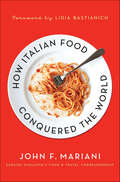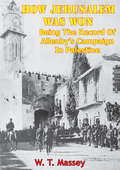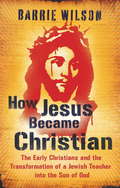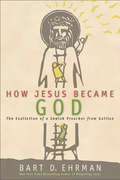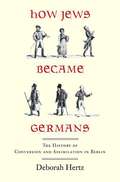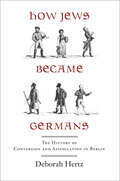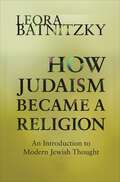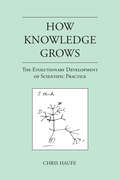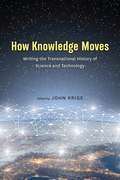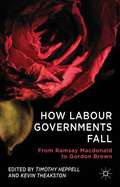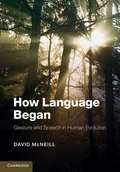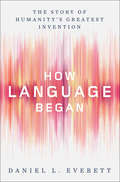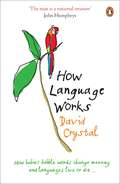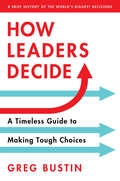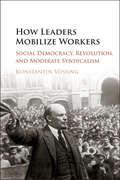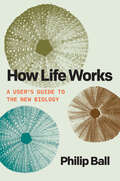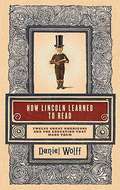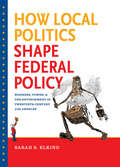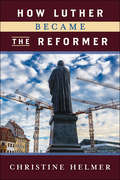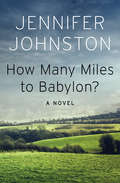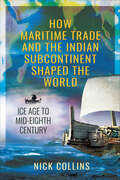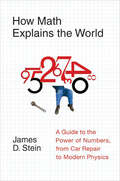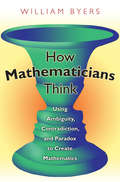- Table View
- List View
How Italian Food Conquered the World
by John F. MarianiNot so long ago, Italian food was regarded as a poor man's gruel-little more than pizza, macaroni with sauce, and red wines in a box. Here, John Mariani shows how the Italian immigrants to America created, through perseverance and sheer necessity, an Italian-American food culture, and how it became a global obsession. The book begins with the Greek, Roman, and Middle Eastern culinary traditions before the boot-shaped peninsula was even called "Italy," then takes readers on a journey through Europe and across the ocean to America alongside the poor but hopeful Italian immigrants who slowly but surely won over the hearts and minds of Americans by way of their stomachs. Featuring evil villains such as the Atkins diet and French chefs, this is a rollicking tale of how Italian cuisine rose to its place as the most beloved fare in the world, through the lives of the people who led the charge. With savory anecdotes from these top chefs and restaurateurs: - Mario Batali- Danny Meyer- Tony Mantuano- Michael Chiarello- Giada de Laurentiis- Giuseppe Cipriani- Nigella LawsonAnd the trials and triumphs of these restaurants:- Da Silvano- Spiaggia- Bottega- Union Square Cafe- Maialino- Rao's- Babbo- Il Cantinori
How Jerusalem Was Won - Being the Record of Allenby’s Campaign in Palestine [Illustrated Edition]: Being the Record of Allenby’s Campaign in Palestine
by William Thomas MasseyIncludes the World War One In The Desert Illustration Pack- 115 photos/illustrations and 19 maps spanning the Desert campaigns 1914-1918"Written by the foremost accredited London newspaper journalist in the Middle East during the Great War, William Massey covered the war in the Middle East as it was fought against the Ottoman Turkish Empire, its German ally and the tribes of the region who supported them. He was aware of the hardships suffered by the British and Colonial troops serving in the difficult climate and later became a champion of those who fought there. He writes of the complete conflict from the battles in the western desert with the Senussi to Aleppo and beyond to the borders of Turkey."-Print Ed.
How Jesus Became Christian: The Early Christians And The Transformation Of A Jewish Teacher Into The Son Of God
by Barrie WilsonHow the early Christians rewrote history, turning a Jewish teacher and messiah into a 'Christian' man-deity, bringing eternal life to all who believeWe often forget the undeniable fact that Jesus was Jewish. He lived and died a Jew, teaching the religion of his forbears and living by the Torah. After his death there was a 'Jesus movement' led by Jesus' brother James in Jerusalem and a 'Christ movement' led by Paul (who never met Jesus) in the Diaspora. The Christ movement deliberately sought to replace and destroy the Jesus movement.The battles of the Jewish community against the Romans, and the chaos after the destruction of the Temple in Jerusalem in AD 70, helped Paul and his party to seduce Jesus' followers away from the strictures of Judaism. Having killed off the historical Jesus, the new Christians turned the religion away from a traditional emphasis on behaviour into the most successful personality cult in recorded history.
How Jesus Became God
by Bart D. EhrmanIn a book that took eight years to research and write, leading Bible scholar Bart D. Ehrman explores how an apocalyptic prophet from the backwaters of rural Galilee crucified for crimes against the state came to be thought of as equal with the one God Almighty Creator of all things. Ehrman sketches Jesus's transformation from a human prophet to the Son of God exalted to divine status at his resurrection. Only when some of Jesus's followers had visions of him after his death--alive again--did anyone come to think that he, the prophet from Galilee, had become God. And what they meant by that was not at all what people mean today.As a historian--not a believer--Ehrman answers the questions: How did this transformation of Jesus occur? How did he move from being a Jewish prophet to being God? The dramatic shifts throughout history reveal not only why Jesus's followers began to claim he was God, but also how they came to understand this claim in so many different ways.Written for secular historians of religion and believers alike, How Jesus Became God will engage anyone interested in the historical developments that led to the affirmation at the heart of Christianity: Jesus was, and is, God.
How Jews Became Germans: The History of Conversion and Assimilation in Berlin
by Deborah Hertz<P>When the Nazis came to power and created a racial state in the 1930s, an urgent priority was to identify Jews who had converted to Christianity over the preceding centuries. With the help of church officials, a vast system of conversion and intermarriage records was created in Berlin, the country’s premier Jewish city. Deborah Hertz’s discovery of these records, the Judenkartei, was the first step on a long research journey that has led to this compelling book. Hertz begins the book in 1645, when the records begin, and traces generations of German Jewish families for the next two centuries. <P>The book analyzes the statistics and explores letters, diaries, and other materials to understand in a far more nuanced way than ever before why Jews did or did not convert to Protestantism. Focusing on the stories of individual Jews in Berlin, particularly the charismatic salon woman Rahel Levin Varnhagen and her husband, Karl, a writer and diplomat, Hertz humanizes the stories, sets them in the context of Berlin’s evolving society, and connects them to the broad sweep of European history.
How Jews Became Germans: The History of Conversion and Assimilation in Berlin
by Deborah HertzA “very readable” history of Jewish conversions to Christianity over two centuries that “tracks the many fascinating twists and turns to this story” (Library Journal).When the Nazis came to power and created a racial state in the 1930s, they considered it an urgent priority to identify Jews who had converted to Christianity over the preceding centuries. With the help of church officials, a vast system of conversion and intermarriage records was created in Berlin, the country’s premier Jewish city. Deborah Hertz’s discovery of these records, the Judenkartei, was the first step on a long research journey that led to this compelling book. Hertz begins the book in 1645, when the records begin, and traces generations of German Jewish families for the next two centuries.The book analyzes the statistics and explores letters, diaries, and other materials to understand in a far more nuanced way than ever before why Jews did or did not convert to Protestantism. Focusing on the stories of individual Jews in Berlin, particularly the charismatic salon woman Rahel Levin Varnhagen and her husband, Karl, a writer and diplomat, Hertz brings out the human stories behind the documents, sets them in the context of Berlin’s evolving society, and connects them to the broad sweep of European history.
How Judaism Became a Religion: An Introduction to Modern Jewish Thought
by Leora BatnitzkyA new approach to understanding Jewish thought since the eighteenth centuryIs Judaism a religion, a culture, a nationality—or a mixture of all of these? In How Judaism Became a Religion, Leora Batnitzky boldly argues that this question more than any other has driven modern Jewish thought since the eighteenth century. This wide-ranging and lucid introduction tells the story of how Judaism came to be defined as a religion in the modern period—and why Jewish thinkers have fought as well as championed this idea.Ever since the Enlightenment, Jewish thinkers have debated whether and how Judaism—largely a religion of practice and public adherence to law—can fit into a modern, Protestant conception of religion as an individual and private matter of belief or faith. Batnitzky makes the novel argument that it is this clash between the modern category of religion and Judaism that is responsible for much of the creative tension in modern Jewish thought. Tracing how the idea of Jewish religion has been defended and resisted from the eighteenth century to today, the book discusses many of the major Jewish thinkers of the past three centuries, including Moses Mendelssohn, Abraham Geiger, Hermann Cohen, Martin Buber, Zvi Yehuda Kook, Theodor Herzl, and Mordecai Kaplan. At the same time, it tells the story of modern orthodoxy, the German-Jewish renaissance, Jewish religion after the Holocaust, the emergence of the Jewish individual, the birth of Jewish nationalism, and Jewish religion in America.More than an introduction, How Judaism Became a Religion presents a compelling new perspective on the history of modern Jewish thought.
How Knowledge Grows: The Evolutionary Development of Scientific Practice
by Chris HaufeAn argument that the development of scientific practice and growth of scientific knowledge are governed by Darwin&’s evolutionary model of descent with modification.Although scientific investigation is influenced by our cognitive and moral failings as well as all of the factors impinging on human life, the historical development of scientific knowledge has trended toward an increasingly accurate picture of an increasing number of phenomena. Taking a fresh look at Thomas Kuhn&’s 1962 work, The Structure of Scientific Revolutions, in How Knowledge Grows Chris Haufe uses evolutionary theory to explain both why scientific practice develops the way it does and how scientific knowledge expands. This evolutionary model, claims Haufe, helps to explain what is epistemically special about scientific knowledge: its tendency to grow in both depth and breadth.Kuhn showed how intellectual communities achieve consensus in part by discriminating against ideas that differ from their own and isolating themselves intellectually from other fields of inquiry and broader social concerns. These same characteristics, says Haufe, determine a biological population&’s degree of susceptibility to modification by natural selection. He argues that scientific knowledge grows, even across generations of variable groups of scientists, precisely because its development is governed by Darwinian evolution. Indeed, he supports the claim that this susceptibility to modification through natural selection helps to explain the epistemic power of certain branches of modern science. In updating and expanding the evolutionary approach to scientific knowledge, Haufe provides a model for thinking about science that acknowledges the historical contingency of scientific thought while showing why we nevertheless should trust the results of scientific research when it is the product of certain kinds of scientific communities.
How Knowledge Moves: Writing the Transnational History of Science and Technology
by John KrigeKnowledge matters, and states have a stake in managing its movement to protect a variety of local and national interests. The view that knowledge circulates by itself in a flat world, unimpeded by national boundaries, is a myth. The transnational movement of knowledge is a social accomplishment, requiring negotiation, accommodation, and adaptation to the specificities of local contexts. This volume of essays by historians of science and technology breaks the national framework in which histories are often written. Instead, How Knowledge Moves takes knowledge as its central object, with the goal of unraveling the relationships among people, ideas, and things that arise when they cross national borders. This specialized knowledge is located at multiple sites and moves across borders via a dazzling array of channels, embedded in heads and hands, in artifacts, and in texts. In the United States, it shapes policies for visas, export controls, and nuclear weapons proliferation; in Algeria, it enhances the production of oranges by colonial settlers; in Vietnam, it facilitates the exploitation of a river delta. In India it transforms modes of agricultural production. It implants American values in Latin America. By concentrating on the conditions that allow for knowledge movement, these essays explore travel and exchange in face-to-face encounters and show how border-crossings mobilize extensive bureaucratic technologies.
How Labour Governments Fall
by Timothy Heppell Kevin TheakstonWhat similarities exist between the reasons for Labour losing office in 2010 and those behind why previous Labour governments were defeated? This edited volume provides a detailed historical appraisal which considers the importance of themes such as economic performance; political leadership and the condition of the Conservatives in opposition.
How Language Began
by David McneillHuman language is not the same as human speech. We use gestures and signs to communicate alongside, or instead of, speaking. Yet gestures and speech are processed in the same areas of the human brain, and the study of how both have evolved is central to research on the origins of human communication. Written by one of the pioneers of the field, this is the first book to explain how speech and gesture evolved together into a system that all humans possess. Nearly all theorizing about the origins of language either ignores gesture, views it as an add-on or supposes that language began in gesture and was later replaced by speech. David McNeill challenges the popular 'gesture-first' theory that language first emerged in a gesture-only form and proposes a groundbreaking theory of the evolution of language which explains how speech and gesture became unified.
How Language Began: The Story Of Humanity's Greatest Invention
by Daniel L. EverettHow Language Began revolutionizes our understanding of the one tool that has allowed us to become the "lords of the planet." Mankind has a distinct advantage over other terrestrial species: we talk to one another. But how did we acquire the most advanced form of communication on Earth? Daniel L. Everett, a “bombshell” linguist and “instant folk hero” (Tom Wolfe, Harper’s), provides in this sweeping history a comprehensive examination of the evolutionary story of language, from the earliest speaking attempts by hominids to the more than seven thousand languages that exist today. Although fossil hunters and linguists have brought us closer to unearthing the true origins of language, Daniel Everett’s discoveries have upended the contemporary linguistic world, reverberating far beyond academic circles. While conducting field research in the Amazonian rainforest, Everett came across an age-old language nestled amongst a tribe of hunter-gatherers. Challenging long-standing principles in the field, Everett now builds on the theory that language was not intrinsic to our species. In order to truly understand its origins, a more interdisciplinary approach is needed—one that accounts as much for our propensity for culture as it does our biological makeup. Language began, Everett theorizes, with Homo Erectus, who catalyzed words through culturally invented symbols. Early humans, as their brains grew larger, incorporated gestures and voice intonations to communicate, all of which built on each other for 60,000 generations. Tracing crucial shifts and developments across the ages, Everett breaks down every component of speech, from harnessing control of more than a hundred respiratory muscles in the larynx and diaphragm, to mastering the use of the tongue. Moving on from biology to execution, Everett explores why elements such as grammar and storytelling are not nearly as critical to language as one might suspect. In the book’s final section, Cultural Evolution of Language, Everett takes the ever-debated “language gap” to task, delving into the chasm that separates “us” from “the animals.” He approaches the subject from various disciplines, including anthropology, neuroscience, and archaeology, to reveal that it was social complexity, as well as cultural, physiological, and neurological superiority, that allowed humans—with our clawless hands, breakable bones, and soft skin—to become the apex predator. How Language Began ultimately explains what we know, what we’d like to know, and what we likely never will know about how humans went from mere communication to language. Based on nearly forty years of fieldwork, Everett debunks long-held theories by some of history’s greatest thinkers, from Plato to Chomsky. The result is an invaluable study of what makes us human.
How Language Works
by David CrystalIn this fascinating survey of everything from how sounds become speech to how names work, David Crystal answers every question you might ever have had about the nuts and bolts of language in his usual highly illuminating way. Along the way we find out about eyebrow flashes, whistling languages, how parents teach their children to speak, how politeness travels across languages and how the way we talk show not just how old we are but where we’re from and even who we want to be.
How Leaders Decide: A Timeless Guide to Making Tough Choices
by Greg Bustin"Greg's collection of the best and worst decisions in history is a practical, nuanced and timeless guide for today's decision-makers."—Mark Schortman, Chairman, Coca-Cola Bottlers Sales & Services, LLC Can today's leaders look to history when making tough decisions?Whether you're running a small team or an international enterprise, all leaders know the feeling of facing a tough choice. It's impossible to see into the future to predict how our decisions play out, but we can look to the momentous decisions of the past for insights on how profound choices are made. Each decision made by influential figures, from Alfred Nobel and Marie Curie to Martin Luther King, Jr., and The Beatles, have shaped our world—and now they can help you make the decisions that will determine the direction of your organization.Guiding you through fifty-two dramatic historical events and decisions that changed the course of our world, How Leaders Decide challenges decision-makers with provocative ideas and leadership lessons that will propel your business forward. Greg Bustin's well-researched and inspiring stories of high-stakes turning points in history and the leaders that made the final call will help you make sure your next decision is the one that changes everything. How Leaders Decide is an essential book for readers of Start with Why and Leaders Eat Last!Additional Praise for How Leaders Decide:"Exceptional leaders are lifelong learners, and Greg has collected, organized and presented these leadership lessons to stimulate learning, inform decision-making, and inspire action. This is a book that all teams and business leaders should read."—Elizabeth Bryant, Chief Learning Officer, Southwest Airlines"Talk about the perfect combination! In How Leaders Decide, Greg Bustin combines fascinating history with succinct leadership insights to showcase 52 of the greatest leadership decisions the world has seen"—Gordon Leidner, author of The Leadership Secrets of Hamilton
How Leaders Mobilize Workers: Social Democracy, Revolution, and Moderate Syndicalism
by Konstantin VössingThis book explains why leaders choose social democracy, revolution, or moderate syndicalism to mobilize workers, and why it matters. In some countries, leaders have responded effectively to their political environment, while others have made ill-fitting choices. Vössing explains not only why leaders make certain choices, but also how their choices affect the success of interest mobilization and subsequent political development. Using quantitative data and historical sources, this book combines an analysis of the formation of class politics in all twenty industrialized countries between 1863 and 1919 with a general theory of political mobilization. It integrates economic, political, and ideational factors into a comprehensive account that highlights the critical role of individual leaders. Explains the causes and consequences of differences in class politics. Conducts a rich and multifaceted empirical analysis using statistical and historical methods. Will appeal to readers who are interested in political mobilization, decision-making, or leadership.
How Life Works: A User’s Guide to the New Biology
by Philip BallA cutting-edge new vision of biology that will revise our concept of what life itself is, how to enhance it, and what possibilities it offers. Biology is undergoing a quiet but profound transformation. Several aspects of the standard picture of how life works—the idea of the genome as a blueprint, of genes as instructions for building an organism, of proteins as precisely tailored molecular machines, of cells as entities with fixed identities, and more—have been exposed as incomplete, misleading, or wrong. In How Life Works, Philip Ball explores the new biology, revealing life to be a far richer, more ingenious affair than we had guessed. Ball explains that there is no unique place to look for an answer to this question: life is a system of many levels—genes, proteins, cells, tissues, and body modules such as the immune system and the nervous system—each with its own rules and principles. How Life Works explains how these levels operate, interface, and work together (most of the time). With this knowledge come new possibilities. Today we can redesign and reconfigure living systems, tissues, and organisms. We can reprogram cells, for instance, to carry out new tasks and grow into structures not seen in the natural world. As we discover the conditions that dictate the forms into which cells organize themselves, our ability to guide and select the outcomes becomes ever more extraordinary. Some researchers believe that ultimately we will be able to regenerate limbs and organs, and perhaps even create new life forms that evolution has never imagined. Incorporating the latest research and insights, How Life Works is a sweeping journey into this new frontier of the life sciences, a realm that will reshape our understanding of life as we know it.
How Lincoln Learned to Read: Twelve Great Americans and the Educations That Made Them
by Daniel WolffBeginning with Benjamin Franklin and ending with Elvis Presley, author Daniel Wolff creates a series of intimate, interlocking profiles of notable Americans that track the nations developing notion of what it means to get a good education.
How Local Politics Shape Federal Policy
by Sarah S. ElkindFocusing on five Los Angeles environmental policy debates between 1920 and 1950, Sarah Elkind investigates how practices in American municipal government gave business groups political legitimacy at the local level as well as unanticipated influence over federal politics. Los Angeles's struggles with oil drilling, air pollution, flooding, and water and power supplies expose the clout business has had over government. Revealing the huge disparities between big business groups and individual community members in power, influence, and the ability to participate in policy debates, Elkind shows that business groups secured their political power by providing Los Angeles authorities with much-needed services, including studying emerging problems and framing public debates. As a result, government officials came to view business interests as the public interest. When federal agencies looked to local powerbrokers for project ideas and political support, local business interests influenced federal policy, too. Los Angeles, with its many environmental problems and its dependence upon the federal government, provides a distillation of national urban trends, Elkind argues, and is thus an ideal jumping-off point for understanding environmental politics and the power of business in the middle of the twentieth century.
How Luther Became the Reformer
by Christine HelmerNo story has been more foundational to triumphalist accounts of Western modernity than that of Martin Luther, the heroic individual, standing before the tribunes of medieval authoritarianism to proclaim his religious and intellectual freedom, “Here I stand!” How Luther Became the Reformer returns to the birthplace of this origin myth, Germany in the late nineteenth century, and traces its development from the end of World War I through the rise of National Socialism. Why were German intellectuals—especially Protestant scholars of religion, culture, and theology—in this turbulent period so committed to this version of Luther’s story? Luther was touted as the mythological figure to promote the cultural unity of Germany as a modern nation; in the myth’s many retellings, from the time of the Weimar Republic forward, Luther attained world-historical status. Helmer finds in this construction of Luther the Reformer a lens through which to examine modernity’s deformations, among them anti-Judaism, anti-Semitism, and anti-Catholicism. Offering a new interpretation of Luther, and by extension of modernity itself, from an ecumenical perspective, How Luther Became the Reformer provides resources for understanding and contesting contemporary assaults on democracy. In this way, the book holds the promise for resistance and hope in dark times.
How Many Miles to Babylon?: A Novel (Penguin Essentials Ser. #63)
by Jennifer JohnstonFrom a Whitbread Award–winning author: A WWI novel of loyalty and friendship &“graced with the immanent lyrical talent of the Irish writers at their best&” (Kirkus Reviews, starred review). Born to an aristocratic family on an estate outside of Dublin, Alexander Moore feels the constraints of his position most acutely in his friendship with Jerry Crowe, a Catholic laborer in town. Jerry is one of the few bright spots in Alec&’s otherwise troubled life. The boys bond over their love of swimming and horses, despite the admonitions of Alec&’s cold and overbearing mother, who scolds her son for venturing outside of his class. When the Great War begins, he seizes the opportunity to escape his overbearing mother and taciturn father, and enlists in the British army. Jerry, too, enlists—not out of loyalty to Britain, but to prepare himself for the Republican cause. Stationed in Flanders, the young men are reunited and find that, while encamped in the trenches, their commonalities are what help them survive. Now a lieutenant and an officer, Alec and Jerry again find their friendship under assault, this time from the rigid Major Glendinning, whose unyielding adherence to rank leads the two men toward a harrowing impasse that will change their lives forever.
How Maritime Trade and the Indian Subcontinent Shaped the World: Ice Age to Mid-Eighth Century
by Nick CollinsWorld-wide maritime trade has been the essential driver of wealth-creation, economic progress and global human contact. Trade and exchange of ideas have been at the heart of economic, social, political, cultural and religious life and maritime international law. These claims are borne out by the history of maritime trade beginning in the Indian Ocean and connecting to Southeast Asia, Japan, the Americas, East Africa, the Middle East especially the Persian Gulf, the Mediterranean and Europe. This development predates the end of the Ice Age with worldwide flooding and stimulated the establishment of land-based civilizations in the above regions with particular effect on the Greek and Roman empires and even China's 'Celestial' empire. The Indian subcontinent was the original major player in maritime trade, linking oceans and regions. Global maritime trade declined with the fall of Mediterranean empires and the 'dark age' in Europe but revived with Indian Ocean and Asian maritime networks. Shipping and trade studies are hugely practical but can be technical, legalistic and even dull for non-specialists. But this history is a broadly based and exciting account of human interaction at multiple levels, for general readers, specialists and practitioners. It is based on huge reading and rare sources and with an attractive writing style, and full of fascinating sidelights illuminating the historical narrative - and from an author with lifelong experience in international shipping.
How Marriage Became One of the Sacraments: The Sacramental Theology of Marriage from its Medieval Origins to the Council of Trent (Cambridge Studies In Law And Christianity)
by Philip L. ReynoldsAmong the contributions of the medieval church to western culture was the idea that marriage was one of the seven sacraments, which defined the role of married folk in the church. Although it had ancient roots, this new way of regarding marriage raised many problems, to which scholastic theologians applied all their ingenuity. By the late Middle Ages, the doctrine was fully established in Christian thought and practice but not yet as dogma. In the sixteenth century, with the entire Catholic teaching on marriage and celibacy and its associated law and jurisdiction under attack by the Protestant reformers, the Council of Trent defined the doctrine as a dogma of faith for the first time but made major changes to it. Rather than focusing on a particular aspect of intellectual and institutional developments, this book examines them in depth and in detail from their ancient precedents to the Council of Trent. Provides a comprehensive, up-to-date and critical analysis. Copiously documented with primary and secondary references for further study. Non-confessional and open to readers of all persuasions, in a field dominated by confessional and often defensive Catholic studies.
How Mass Atrocities End
by Bridget Conley-ZilkicGiven the brutality of mass atrocities, it is no wonder that one question dominates research and policy: what can we, who are not at risk, do to prevent such violence and hasten endings? But this question skips a more fundamental question for understanding the trajectory of violence: how do mass atrocities actually end? This volume presents an analysis of the processes, decisions, and factors that help bring about the end of mass atrocities. It includes qualitatively rich case studies from Burundi, Guatemala, Indonesia, Sudan, Bosnia, and Iraq, drawing patterns from wide-ranging data. As such, it offers a much needed correction to the popular 'salvation narrative' framing mass atrocity in terms of good and evil. The nuanced, multidisciplinary approach followed here represents not only an essential tool for scholars, but an important step forward in improving civilian protection.
How Math Explains the World: A Guide to the Power of Numbers, from Car Repair to Modern Physics
by James D. Stein&“Explores the application of math to problem solving in the everyday. . . . [W]ill appeal to both casual and serious fans of math or physics.&” —Publishers Weekly In How Math Explains the World, mathematician Stein reveals how seemingly arcane mathematical investigations and discoveries have led to bigger, more world-shaking insights into the nature of our world. In the four main sections of the book, Stein tells the stories of the mathematical thinkers who discerned some of the most fundamental aspects of our universe. From their successes and failures, delusions, and even duels, the trajectories of their innovations—and their impact on society—are traced in this fascinating narrative. Quantum mechanics, space-time, chaos theory and the workings of complex systems, and the impossibility of a &“perfect&” democracy are all here. Stein's book is both mind-bending and practical, as he explains the best way for a salesman to plan a trip, examines why any thought you could have is imbedded in the number p, and—perhaps most importantly—answers one of the modern world's toughest questions: why the garage can never get your car repaired on time. Friendly, entertaining, and fun, How Math Explains the World is the first book by one of California's most popular math teachers, a veteran of both &“math for poets&” and Princeton's Institute for Advanced Studies. And it's perfect for any reader wanting to know how math makes both science and the world tick.
How Mathematicians Think: Using Ambiguity, Contradiction, and Paradox to Create Mathematics
by William ByersTo many outsiders, mathematicians appear to think like computers, grimly grinding away with a strict formal logic and moving methodically--even algorithmically--from one black-and-white deduction to another. Yet mathematicians often describe their most important breakthroughs as creative, intuitive responses to ambiguity, contradiction, and paradox. A unique examination of this less-familiar aspect of mathematics, How Mathematicians Think reveals that mathematics is a profoundly creative activity and not just a body of formalized rules and results. Nonlogical qualities, William Byers shows, play an essential role in mathematics. Ambiguities, contradictions, and paradoxes can arise when ideas developed in different contexts come into contact. Uncertainties and conflicts do not impede but rather spur the development of mathematics. Creativity often means bringing apparently incompatible perspectives together as complementary aspects of a new, more subtle theory. The secret of mathematics is not to be found only in its logical structure. The creative dimensions of mathematical work have great implications for our notions of mathematical and scientific truth, and How Mathematicians Think provides a novel approach to many fundamental questions. Is mathematics objectively true? Is it discovered or invented? And is there such a thing as a "final" scientific theory? Ultimately, How Mathematicians Think shows that the nature of mathematical thinking can teach us a great deal about the human condition itself.
